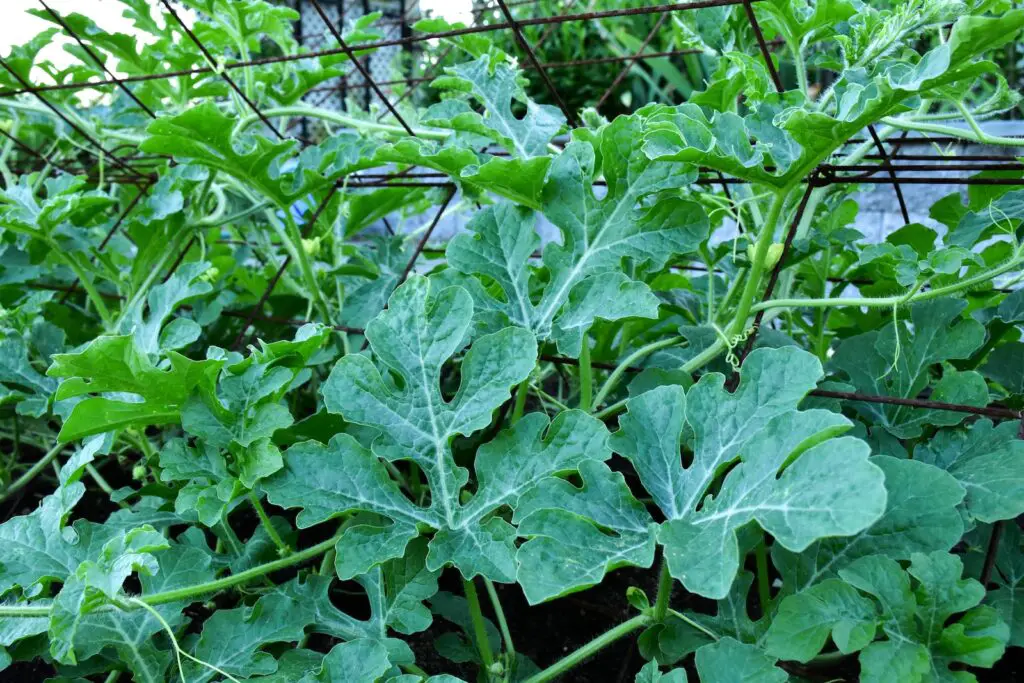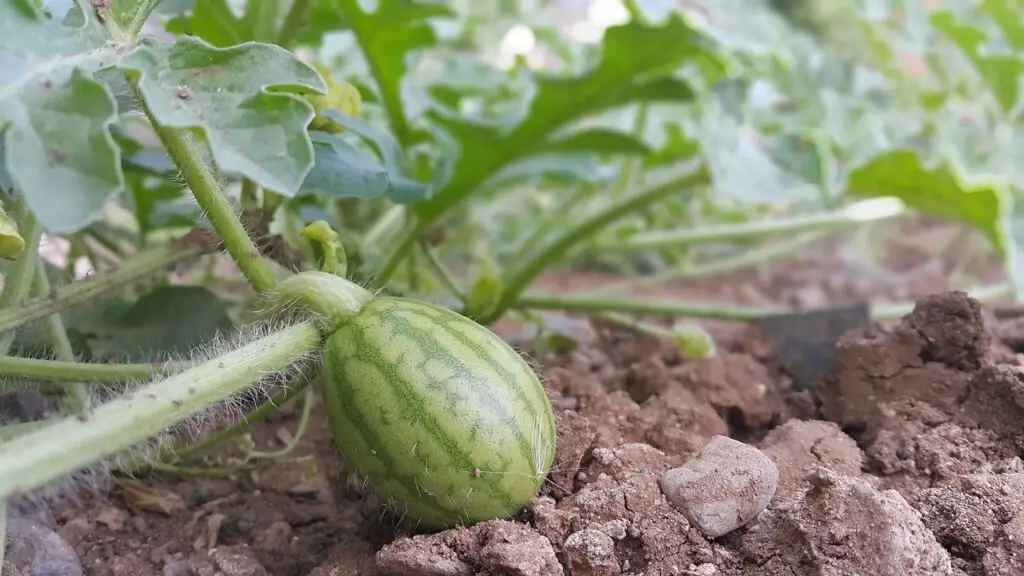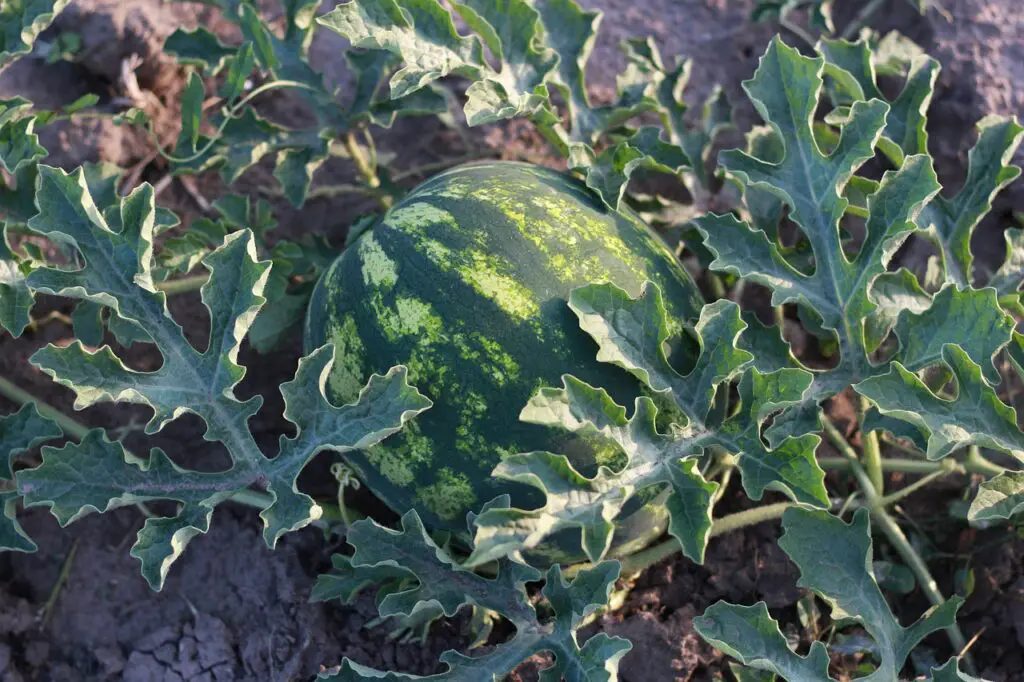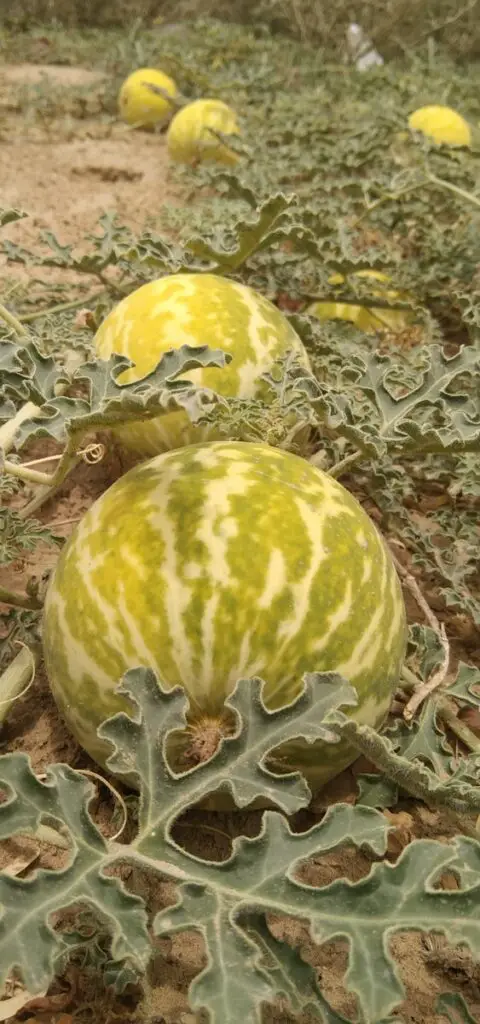
Watermelon is a popular summer fruit known for its juicy, sweet flesh and refreshing taste. However, many people may not be familiar with what the leaves of a watermelon plant look like. Watermelon leaves are an important part of the plant and play a crucial role in the growth and development of the fruit.
Watermelon leaves are large, lobed, and have a distinct green color. They are typically 10-20 cm in length and 8-15 cm in width, with a rough texture and jagged edges. The leaves are attached to the stem of the watermelon plant by a long petiole, which allows them to move and adjust to changes in sunlight and temperature.
When fully grown, the watermelon leaves form a dense canopy that provides shade and protection for the fruit. They also help to regulate the amount of water and nutrients that the plant receives, ensuring that the fruit grows to its full potential. Overall, understanding what watermelon leaves look like is an important part of growing and caring for this delicious fruit.
Table of Contents
Identifying Watermelon Leaves

Watermelon leaves are an important part of identifying watermelon plants. They have unique characteristics that distinguish them from other cucurbits. In this section, we will discuss the key features of watermelon leaves.
Color and Texture
Watermelon leaves are typically green in color and have a rough, textured surface. The leaves can also have a mottled appearance, with light and dark green areas. In some cases, the leaves may have white striping.
Lobed Structure
Watermelon leaves have a lobed structure, which means that they have deep indentations or clefts. The lobes of the leaves are triangular in shape and can be quite large. The lobed structure of the leaves is one of the most distinguishing features of watermelon plants.
Leaf Arrangement
The leaves of watermelon plants are arranged alternately on the stem. This means that each leaf is attached to the stem at a different point, rather than directly across from another leaf. The leaves are also spaced apart from each other on the stem.
Comparisons with Other Cucurbits
Watermelon leaves can be distinguished from other cucurbits, such as cucumber, squash, and pumpkin, by their lobed structure and leaf arrangement. Cucumber leaves, for example, are not lobed and have a smooth surface. Squash and pumpkin leaves are also not lobed, but they have a distinctively different shape. Watermelon leaves are larger and more triangular than the leaves of other cucurbits.
In conclusion, identifying watermelon leaves is an important part of identifying watermelon plants. The leaves have a unique lobed structure, green color, and rough texture. By understanding the key features of watermelon leaves, you can easily distinguish them from other cucurbits.
Watermelon Plant Growth and Development

From Seed to Seedling
Watermelon seeds are typically planted in warm soil, around 70-90°F (21-32°C), in the springtime. The seeds will germinate within 4-7 days, and the first true leaves will appear within 7-10 days. As the seedling grows, it will develop tendrils that will help it climb and sprawl.
Vine Development
As the watermelon plant grows, it will develop a sprawling vine that can reach up to 20 feet (6 meters) in length. The vine will produce male and female flowers, which are necessary for fruit development.
Flower Formation
The watermelon plant will produce both male and female flowers, with the female flowers developing into fruit. The male flowers will appear first, followed by the female flowers. The female flowers can be identified by the small fruit that will begin to develop at the base of the flower.
Fruit Development
Once the female flowers have been pollinated, the developing fruit will begin to grow rapidly. Watermelons can grow to be quite large, with some varieties weighing over 100 pounds (45 kg). As the fruit develops, it will change from green to yellow or cream-colored on the bottom, indicating that it is ripe.
During the fruit development stage, it is important to ensure that the watermelon plant has plenty of water and nutrients. Inadequate water or nutrients can result in stunted growth or poor fruit quality.
Overall, watermelon plants are relatively easy to grow and can produce a bountiful harvest with proper care and attention.
Caring for Watermelon Plants

Planting Considerations
Watermelon plants prefer warm soil and air temperatures, so it is important to wait until after the last frost date before planting them outdoors. The soil should be well-draining, with excellent drainage being especially important for preventing root rot. Sandy or clay soils can be used, but the soil should be amended with compost or other organic matter to improve soil quality. Watermelon plants can be grown in hills or rows, with hills being preferred for better root growth.
Water and Sunlight Needs
Watermelon plants require consistent moisture throughout the growing season, with about 1-2 inches of water per week being ideal. It is important to water deeply and infrequently rather than shallowly and frequently to encourage deep root growth. Watermelon plants also require full sunlight, with at least 6-8 hours of direct sunlight per day being necessary for optimal growth.
Fertilization and Soil Requirements
Watermelon plants require soil that is rich in nutrients, particularly potassium. Fertilizing with a balanced fertilizer or one that is high in potassium can help ensure the plants have the nutrients they need. It is important to avoid over-fertilizing, as this can lead to excessive vegetative growth at the expense of fruit production. Soil temperature should also be considered, as watermelon plants require warm soil temperatures for optimal growth.
Pest and Disease Control
Watermelon plants can be susceptible to a variety of pests and diseases, including aphids, cucumber beetles, and powdery mildew. Using row covers and disease-resistant varieties can help prevent these issues. Additionally, maintaining good environmental conditions, such as proper spacing between plants and good air circulation, can also help prevent disease. If pest or disease issues do arise, there are a variety of organic and chemical control options available.
Overall, caring for watermelon plants involves providing them with the right growing conditions and addressing any pest or disease issues that may arise. With proper care, watermelon plants can produce delicious fruit that is perfect for summer picnics and barbecues.
Harvesting and Storing Watermelons
Determining Ripeness
Before harvesting watermelons, it is important to determine if they are ripe. A ripe watermelon will have a dull, matte appearance on the surface and a creamy yellow spot where it rested on the ground. The stem will also become dry and brown. If the watermelon has a shiny surface, it is likely not ripe yet.
Another way to determine ripeness is to tap the watermelon. A ripe watermelon will produce a deep, hollow sound, while an unripe one will sound dull. It is important to note that watermelons will not continue to ripen after they are harvested, so it is important to wait until they are fully ripe before harvesting.
Harvest Techniques
When harvesting watermelons, it is important to be gentle to avoid damaging the fruit. Using a sharp knife, cut the stem about 1 inch above the fruit. It is important to leave some stem attached to the watermelon to help it last longer in storage.
If the watermelon is particularly large, it may be helpful to have a partner hold the fruit steady while cutting the stem. It is also important to avoid dropping or throwing the watermelon, as this can cause damage and decrease its shelf life.
Storage Tips
Watermelons should be stored in a cool, dry place with good ventilation. They should not be stored in direct sunlight or in temperatures below 50°F, as this can cause the fruit to decay more quickly.
If storing multiple watermelons, it is important to keep them separated to avoid damage. One method for storage is to wrap each watermelon in newspaper or place them in individual cardboard boxes. This will help to absorb any excess moisture and prevent the fruit from touching each other.
In summary, harvesting and storing watermelons requires careful attention to detail. By determining ripeness, using gentle harvesting techniques, and storing the fruit in a cool, dry place, watermelons can last for several weeks and provide a delicious and refreshing treat.
Varieties of Watermelons
Common Watermelon Varieties
Watermelons come in a variety of shapes, sizes, and colours. Some of the most common watermelon varieties include:
- Sugar Baby: This is a small, round fruit with a dark green rind and sweet, juicy flesh. It is a popular choice for home gardeners as it is easy to grow and matures quickly.
- Crimson Sweet: This variety has a striped green rind and bright red flesh. It is known for its sweet flavour and is a popular choice for commercial growers.
- Charleston Gray: This variety is known for its large size and oblong shape. It has a light green rind and sweet, juicy flesh. It is a popular choice for those who want to grow watermelons for competitions.
Unique Watermelon Varieties
In addition to the common varieties, there are also some unique watermelon varieties that are worth trying. Some of these include:
- Golden Midget: This is a small, round fruit with a yellow rind and sweet, juicy flesh. It is a popular choice for those who want to grow watermelons in small spaces as it is a compact plant.
- Moon and Stars: This variety has a dark green rind with yellow spots that resemble stars. It also has a yellow moon shape on the underside of the fruit. It has a sweet flavour and is a popular choice for home gardeners.
- Cream of Saskatchewan: This variety has a creamy white rind and sweet, juicy flesh. It is a popular choice for those who want to try something different.
Overall, there are many watermelon varieties to choose from, each with its own unique characteristics. Whether you prefer small, round fruits or large, oblong ones, there is a watermelon variety out there for everyone.
Nutritional Benefits of Watermelons
Watermelon is not only a delicious fruit but also a nutritious one. It is rich in vitamins, minerals, and antioxidants that are beneficial for the body. Here are some of the nutritional benefits of watermelons:
Vitamin A
Watermelon is a good source of vitamin A, which is essential for maintaining healthy eyesight, skin, and immune system. One cup of diced watermelon contains about 15% of the daily recommended intake of vitamin A.
Vitamin C
Watermelon is also high in vitamin C, which is important for maintaining healthy skin, bones, and teeth. One cup of diced watermelon contains about 20% of the daily recommended intake of vitamin C.
Dietary Fiber
Watermelon is a good source of dietary fiber, which is important for maintaining digestive health and preventing constipation. One cup of diced watermelon contains about 1 gram of dietary fiber.
Lycopene
Watermelon is one of the best dietary sources of lycopene, a powerful antioxidant that has been linked to a reduced risk of heart disease and certain types of cancer. Lycopene is what gives watermelon its red color. One cup of diced watermelon contains about 6,500 micrograms of lycopene.
Citrulline
Watermelon is also a good source of citrulline, an amino acid that has been shown to improve blood flow and reduce muscle soreness. Citrulline is converted into arginine in the body, which is a precursor to nitric oxide, a molecule that helps to relax blood vessels and improve circulation.
Edible Fruit
Finally, watermelon is a delicious and refreshing fruit that is perfect for summertime snacking. It is low in calories and high in water content, making it a great choice for those who are trying to lose weight or stay hydrated. Plus, it is easy to slice and serve, making it a popular choice for picnics and barbecues.
In conclusion, watermelon is a nutritious and delicious fruit that is rich in vitamins, minerals, and antioxidants. It is a great choice for maintaining overall health and preventing chronic diseases.
Conclusion
In conclusion, watermelon leaves are typically large, lobed, and deeply cut with a rough texture. They are arranged alternately on the stem and have a dark green color. The leaves are an important part of the watermelon plant and play a crucial role in photosynthesis, which is essential for the growth and development of the fruit.
If you are growing watermelon, it is important to pay attention to the health of the leaves. Yellowing or wilting leaves can be a sign of disease or nutrient deficiency, and should be addressed promptly to prevent damage to the plant.
Gardening enthusiasts should keep in mind that watermelon leaves require plenty of sunlight, water, and nutrients to thrive. Proper care and maintenance can help ensure a healthy and bountiful harvest.
Overall, understanding the characteristics and needs of watermelon leaves is an important aspect of growing watermelons successfully. With the right care and attention, gardeners can enjoy a delicious and refreshing fruit that is perfect for summertime enjoyment.